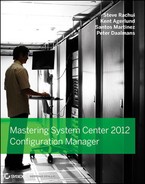Introduction
Microsoft has accomplished a lot in making System Center 2012 Configuration Manager the product that it is today. It started as a little-known niche product, back when there wasn’t even really a name for what it did, and it’s now the premier configuration management product on the market.
This book is written by a group of individuals who have endured the growing pains of this product, some even from day one, and who have even helped Microsoft improve Configuration Manager with countless hours of real-world use and testing.
Welcome to Mastering System Center 2012 Configuration Manager. We hope that you find this book helpful in learning how to use Configuration Manager to its full potential.
The Mastering Series
The Mastering series from Sybex provides outstanding instruction for readers with intermediate and advanced skills in the form of top-notch training and development for those already working in their field and provides clear, serious education for those aspiring to become pros. Every Mastering book includes the following:
- Real-world scenarios, ranging from case studies to interviews that show how the tool, technique, or knowledge presented is applied in actual practice
- Skill-based instruction, with chapters organized around real tasks rather than abstract concepts or subjects
- Self-review questions, so you can be certain you’re equipped to do the job right
What This Book Covers
Mastering System Center 2012 Configuration Manager covers Microsoft’s System Center 2012 Configuration Manager. We detail the changes to Configuration Manager since 2007.
These new features include, but are not limited to, the following:
- A completely new mechanism for content distribution—focusing on the needs of the user while retaining the ability to distribute to systems as well
- A user self-service catalog for content deployment
- Updates to software update management and operating system deployment
- The ability to manage mobile devices, including Windows Phone, iPhones, iPads, Android, and more
- A robust alerting mechanism
- A redesigned infrastructure to increase scale and reduce complexity
What You Need to Get the Most Out of This Book
To be able to follow the step-by-step instructions in this book, it is recommended that you have a minimum of Windows Server 2008 R2 x64 and SQL Server 2008 R2 with all the applicable updates installed; read more on this subject in Chapter 2. Also, make sure you have the media for Configuration Manager 2012 RTM, because we will go through installing this software in the first few chapters. Your computer also needs an Internet connection so you can download updates in various parts of the installation process. Evaluation versions of any of this software are fine for our purposes.
How We Structured This Book
To help you understand the features of Configuration Manager, we have structured this book to match the names of features as they are listed in the Configuration Manager administrative console wherever possible, with a few exceptions.
Chapter 1, “Overview of Operations Management,” covers general management concepts, such as ITIL and MOF, and how System Center 2012 Configuration Manager supports those concepts.
Chapter 2, “Planning a Configuration Manager Infrastructure,” covers site roles, how they are leveraged, and their application in your enterprise.
Chapter 3, “Migrating from Configuration Manager 2007,” covers the process of moving from ConfigMgr 2007 to ConfigMgr 2012. Discussions include planning the migration, using the new migration tool, and more.
Chapter 4, “Installation and Site Role Configuration,” covers the details of site role installation, configuration, and troubleshooting.
Chapter 5, “Role-Based Administration,” covers the new approach to security in ConfigMgr 2012. Role-based security is used to assign the access needed for specific job functions.
Chapter 6, “Client Installation,” covers client installation aspects in relation to Configuration Manager 2012, such as the various installation methods found within Configuration Manager 2012.
Chapter 7, “Application Deployment,” provides a comprehensive look at planning, configuring, and using the new application deployment model in ConfigMgr 2012, including elements like deployments, deployment types, dependencies, rules, and relationships.
Chapter 8, “Software Updates,” gives you a step-by-step guide of this completely redesigned feature that is now based on Windows Server Update Services.
Chapter 9, “Operating System Deployment,” gives you an in-depth look at how Configuration Manager 2012 allows an administrator to deploy a single operating system to multiple types of machines.
Chapter 10, “Asset Intelligence,” covers the mechanism ConfigMgr 2012 uses for tracking assets, including hardware, software, and licensing.
Chapter 11, “Inventory and Software Metering,” focuses on the heart of Configuration Management Server 2012, one of the core features that most other features tie into.
Chapter 12, “Reporting,” discusses probably the most used aspect of Configuration Manager by users outside the IT department. It gives other users the ability to report on various parts of Configuration Manager.
Chapter 13, “Compliance Settings,” offers an in-depth look at setting up a predefined level of standards for all your devices and how Configuration Manager 2012 will ensure your clients are maintained at that standard.
Chapter 14, “Mobile Device Management,” gives you an inside look at mobile devices and how Configuration Manager 2012 can manage these types of devices.
Chapter 15, “Troubleshooting,” shows how to ensure your Configuration Manager 2012 environment stays healthy and gives you a baseline of where and what to look for if problems arise.
Chapter 16, “Disaster Recovery,” provides the information necessary to protect your Configuration Manager databases by backing them up properly so that you can use those backups to recover from a disaster if it strikes.
Chapter 17, “System Center Endpoint Protection,” details the use of ConfigMgr to manage malware protection throughout the computing environment.
Chapter 18, “Client Health,” covers the new mechanism ConfigMgr 2012 uses to help ensure clients remain healthy.
Errata
We have done our best to make sure that the content in this book is as accurate as possible at the time it was written. If you discover any mistakes that we have missed in the editing process, please let us know at http://sybex.custhelp.com so we can address them in future versions of this book.
